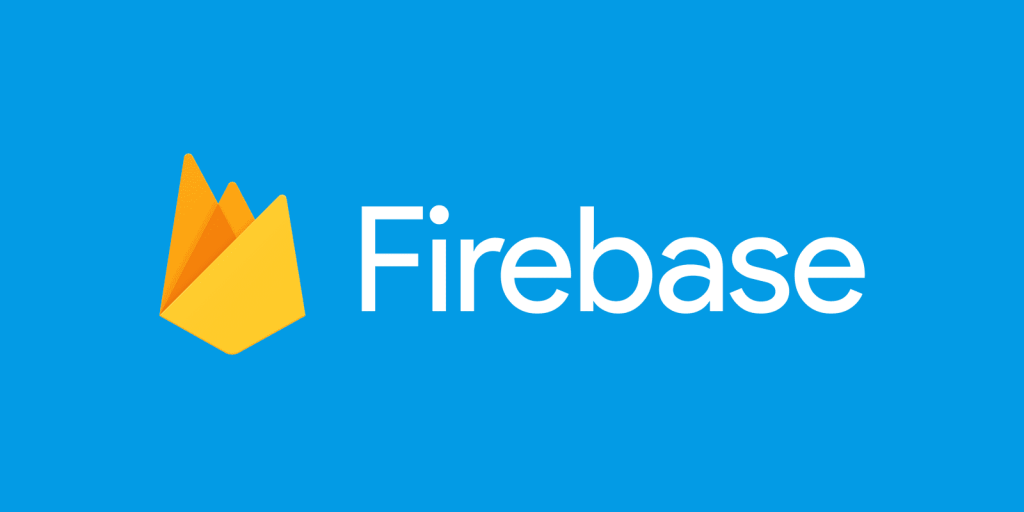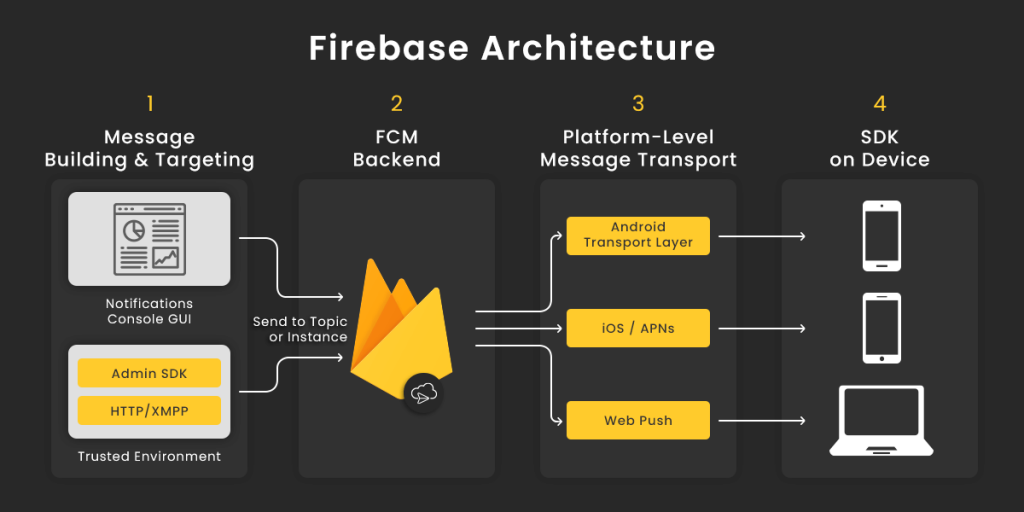What is Firebase?

Firebase is a comprehensive mobile and web application development platform developed by Firebase, Inc. and later acquired by Google. Firebase offers a suite of tools and services to help developers build, grow, and scale applications quickly and efficiently. It provides both backend services (such as a real-time database, authentication, and cloud functions) and frontend services (like hosting, hosting, and performance monitoring).
What is top use cases of Firebase?
Top Use Cases of Firebase:
- Real-time Database:
- Description: Firebase Realtime Database is a NoSQL cloud database that allows developers to store and sync data in real-time across connected clients.
- Use Case: Real-time collaboration apps, live chat applications, multiplayer games.
- Authentication:
- Description: Firebase Authentication provides a secure and easy-to-implement authentication system for user sign-up, sign-in, and management.
- Use Case: User authentication for mobile apps, web apps, and secure access control.
- Cloud Firestore:
- Description: Firestore is a scalable NoSQL cloud database that allows developers to store and sync data across devices. It supports real-time data synchronization and offline capabilities.
- Use Case: Document-centric applications, content management systems, collaborative apps.
- Cloud Functions:
- Description: Firebase Cloud Functions enables developers to run backend code in response to events triggered by Firebase features and HTTPS requests.
- Use Case: Serverless computing, backend logic for Firebase features, event-driven automation.
- Firebase Hosting:
- Description: Firebase Hosting provides a fast and secure web hosting service for serving static and dynamic content.
- Use Case: Hosting web applications, static websites, Progressive Web Apps (PWAs).
- Cloud Storage:
- Description: Firebase Cloud Storage allows developers to store and serve user-generated content such as images, videos, and other files.
- Use Case: Media storage for apps, file uploads and downloads, content delivery.
- Cloud Messaging (FCM):
- Description: Firebase Cloud Messaging (FCM) is a cloud solution for messages on iOS, Android, and web applications. It provides reliable and efficient connection between servers and devices.
- Use Case: Push notifications, in-app messaging, real-time updates.
- Authentication with AuthUI:
- Description: Firebase AuthUI is a pre-built UI library for authentication. It simplifies the process of adding sign-in methods to your app.
- Use Case: Quickly integrating user authentication UI into applications.
- Firebase Analytics:
- Description: Firebase Analytics provides insights into user behavior and engagement, helping developers understand app usage and user interactions.
- Use Case: App performance analysis, user engagement tracking, conversion tracking.
- Remote Config:
- Description: Firebase Remote Config allows developers to modify the appearance and behavior of their apps without publishing an app update.
- Use Case: A/B testing, feature toggling, dynamically updating app content.
- Dynamic Links:
- Description: Firebase Dynamic Links are deep links that can dynamically change behavior depending on the platform, time, or other conditions.
- Use Case: Deep linking, personalized onboarding experiences, referral programs.
- Machine Learning with ML Kit:
- Description: Firebase ML Kit provides ready-to-use, on-device machine learning models for common mobile use cases, such as text recognition, face detection, and image labeling.
- Use Case: Image recognition, text extraction, face detection in mobile apps.
- Performance Monitoring:
- Description: Firebase Performance Monitoring helps developers understand the performance characteristics of their apps.
- Use Case: Identify and fix performance issues, monitor app responsiveness.
- Crashlytics:
- Description: Firebase Crashlytics provides detailed crash reports in real-time, helping developers identify and fix issues.
- Use Case: Crash reporting, bug fixing, improving app stability.
- AdMob Integration:
- Description: Firebase integrates with AdMob for serving ads in mobile apps.
- Use Case: Monetizing apps through ads, optimizing ad revenue.
Firebase is known for its ease of use, real-time capabilities, and seamless integration with other Google Cloud services. It is widely used by developers for building and maintaining a variety of applications, from small-scale projects to large-scale enterprise solutions.
What are feature of Firebase?

Features of Firebase:
- Realtime Database:
- Description: Firebase provides a NoSQL cloud database that supports real-time data synchronization. It enables collaborative and responsive applications with instant updates across connected devices.
- Authentication:
- Description: Firebase Authentication offers secure and simple user authentication methods, supporting email/password, social logins (Google, Facebook, etc.), and anonymous authentication.
- Cloud Firestore:
- Description: Firestore is a scalable NoSQL cloud database with features like real-time data synchronization, offline support, and a flexible data model based on documents and collections.
- Cloud Functions:
- Description: Firebase Cloud Functions allow developers to run backend code in response to events triggered by Firebase features or HTTP requests. It supports serverless computing and event-driven architectures.
- Firebase Hosting:
- Description: Firebase Hosting provides fast and secure web hosting for static and dynamic content. It supports features like custom domains, SSL, and automatic scaling.
- Cloud Storage:
- Description: Firebase Cloud Storage allows developers to store and serve user-generated content such as images, videos, and other files. It provides scalable and secure cloud-based storage.
- Cloud Messaging (FCM):
- Description: Firebase Cloud Messaging (FCM) is a cloud solution for messages on iOS, Android, and web applications. It enables push notifications, in-app messaging, and real-time updates.
- Authentication with AuthUI:
- Description: Firebase AuthUI is a pre-built UI library for authentication. It simplifies the process of adding sign-in methods to applications with customizable UI components.
- Firebase Analytics:
- Description: Firebase Analytics provides insights into user behavior and engagement. It helps developers track user interactions, measure app performance, and make data-driven decisions.
- Remote Config:
- Description: Firebase Remote Config allows developers to remotely configure the behavior and appearance of their apps without the need for app updates. It supports A/B testing and feature toggling.
- Dynamic Links:
- Description: Firebase Dynamic Links are deep links that can dynamically change behavior based on conditions. They enable features like deep linking, personalized onboarding, and referral programs.
- Machine Learning with ML Kit:
- Description: Firebase ML Kit provides on-device machine learning models for common mobile use cases. It includes features like text recognition, face detection, image labeling, and more.
- Performance Monitoring:
- Description: Firebase Performance Monitoring helps developers understand the performance characteristics of their apps. It provides insights into app responsiveness and identifies performance bottlenecks.
- Crashlytics:
- Description: Firebase Crashlytics provides detailed crash reports in real-time. It helps developers identify and fix issues by providing information on the root cause of crashes.
- AdMob Integration:
- Description: Firebase integrates with AdMob for serving ads in mobile apps. This allows developers to monetize their apps through advertisements and optimize ad revenue.
What is the workflow of Firebase?
Workflow of Firebase:
- Initialize Firebase Project:
- Action: Set up a new Firebase project.
- Activity: Create a project on the Firebase Console, configure project settings, and obtain configuration details.
- Choose Firebase Services:
- Action: Select the Firebase services needed for the project.
- Activity: Enable and configure services such as Realtime Database, Authentication, Cloud Firestore, Hosting, etc., based on project requirements.
- Integrate SDKs:
- Action: Integrate Firebase SDKs into the application.
- Activity: Add the Firebase SDK to the project using platform-specific tools (e.g., Gradle for Android, CocoaPods for iOS). Initialize Firebase in the app.
- Develop Application:
- Action: Write application code and use Firebase services.
- Activity: Implement features using Firebase APIs, such as reading/writing data to the database, authenticating users, sending push notifications, etc.
- Test Locally:
- Action: Test the application locally during development.
- Activity: Use local development environments to ensure that Firebase services are functioning as expected.
- Deploy to Firebase:
- Action: Deploy the application to Firebase Hosting.
- Activity: Use Firebase CLI or other deployment methods to deploy the app to Firebase Hosting.
- Monitor and Analyze:
- Action: Monitor the application in production.
- Activity: Utilize Firebase Analytics, Performance Monitoring, and Crashlytics to gain insights into user behavior, app performance, and identify and resolve issues.
- Update and Maintain:
- Action: Update the application and maintain it over time.
- Activity: Make code updates, add new features, and manage dependencies. Use Firebase services to dynamically update app behavior (Remote Config).
The workflow is iterative, allowing developers to continuously update, test, and deploy the application while leveraging Firebase services for various functionalities. Firebase’s integrated toolset provides a streamlined development and deployment experience for building modern web and mobile applications.
How Firebase Works & Architecture?

Firebase is a platform by Google that provides a suite of tools and services for building and deploying web and mobile applications. It offers various features including:
- Real-time database: Stores and synchronizes data across clients in real-time.
- Cloud Firestore: A scalable and flexible NoSQL database.
- Cloud Storage: Secure storage for files and media.
- Cloud Functions: Serverless functions triggered by events.
- Authentication: User authentication and authorization.
- Hosting: Static and dynamic web hosting.
- Cloud Messaging: Push notifications for mobile apps.
- Analytics: Track app usage and user behavior.
Firebase Architecture:
- Client SDKs: Available for various platforms (Android, iOS, web, etc.) to access Firebase services directly from your applications.
- Firebase Backend: Comprises Google Cloud infrastructure for data storage, authentication, and other services.
- Firebase Realtime Database: Uses a JSON tree structure for storing data and uses WebSockets for real-time synchronization.
- Cloud Firestore: Uses a document-oriented model for storing data and supports offline access.
- Firebase Cloud Storage: Leverages Google Cloud Storage for secure and scalable file storage.
- Firebase Cloud Functions: Executes code in response to events like database changes or user actions.
Benefits of using Firebase:
- Rapid development: Firebase simplifies development by providing pre-built services and eliminating server-side infrastructure management.
- Real-time data synchronization: Ensures data is always up-to-date across clients for a seamless user experience.
- Scalability: Firebase automatically scales to accommodate growing user bases and data volumes.
- Security: Google Cloud infrastructure provides robust security features for data and user information.
- Easy integration: Firebase integrates seamlessly with other Google Cloud services.
By understanding how Firebase works and its architecture, you can leverage its features to build powerful and scalable web and mobile applications.
How to Install and Configure Firebase?
Installing and configuring Firebase involves setting up the platform in your development environment and preparing it for use with your application. Here’s a step-by-step guide:
1. Prerequisites:
- Web Development Tools: You’ll need a web development environment like a code editor (Visual Studio Code, Sublime Text, etc.) and a web browser.
- Firebase Account: Create a free account.
2. Generate a Firebase Project:
- Go to the Firebase console and press on “Add project”.
- Enter a project name and choose the appropriate Google Cloud account to associate it with.
- Accept the terms and conditions and press “Create project”.
3. Install Firebase CLI (optional):
- The Firebase CLI offers command-line access to various Firebase features.
- Download and install the CLI for your operating system.
- Verify the installation by running
firebase --versionin your terminal.
4. Initialize Firebase in your Project:
- Open your project directory in your terminal.
- Run
firebase initto initialize Firebase to your project. - Choose the desired features you want to use, like Database, Authentication, etc.
- Follow the on-screen prompts to configure settings for each chosen feature.
- Firebase automatically creates a
firebase.jsonfile in your project directory, which stores configuration details.
5. Add SDKs to your Application:
- Firebase provides SDKs for various platforms like Android, iOS, web, etc.
- Choose the appropriate SDK for your platform and follow the installation instructions provided in the documentation.
- Configure the SDK with your project details obtained from the Firebase console.
6. Deploy your Application:
- Once you have configured Firebase and implemented its features in your application, you can deploy it to production.
- Firebase offers various deployment options depending on your platform and chosen features.
- Follow the specific deployment instructions for your chosen platform and tools.
7. Additional Configuration:
- You can further customize the behavior and functionality of Firebase features through configuration options.
- Explore the Firebase documentation and resources for detailed information on configuring specific features.
- Utilize the Firebase console and CLI to manage your project, monitor usage, and access data.
Important Tips:
- Start with simple features and gradually add more complexity as you become more familiar with Firebase.
- Use online resources and tutorials for assistance and troubleshooting.
- Join the Firebase community forums and groups for support and interaction with other developers.
- Refer to the official documentation for comprehensive information and configuration options.
By following these steps and exploring the available resources, you can effectively install, configure, and use Firebase to build powerful and scalable web and mobile applications. Remember, continuous learning and experimentation are key to mastering the platform and unlocking its full potential.
Fundamental Tutorials of Firebase: Getting started Step by Step

Following is a breakdown of basic tutorials to get you started with Firebase:
1. Setting Up:
- Create a free Firebase account
- Install the Firebase CLI (optional) for command-line access
- Download and install platform-specific SDKs (Android, iOS, Web, etc.)
2. Initialize Firebase:
- Open your project directory in your terminal.
- Run
firebase initto initialize Firebase to your project. - Choose desired features like Database, Authentication, etc.
- Configure settings for each chosen feature and accept prompts.
- A
firebase.jsonfile with configuration details is created.
3. Explore Firebase Services:
- Database:
- Use the Realtime Database for real-time data synchronization or Cloud Firestore for a flexible NoSQL database.
- Add, update, and retrieve data using the SDKs.
- Learn about data structures, security rules, and offline access.
- Authentication:
- Implement user authentication using email/password, social logins, or phone numbers.
- Manage user profiles and permissions.
- Utilize Firebase Authentication SDKs for secure user access.
- Storage:
- Store files and images securely in Cloud Storage.
- Upload and download files using the SDKs or console.
- Configure access control and public/private storage options.
- Cloud Functions:
- Develop server-side functions triggered by events (database changes, user actions, etc.).
- Use Cloud Functions to automate tasks and implement backend logic.
- Learn about Node.js development for Cloud Functions.
4. Build a Simple Application:
- Combine Firebase services to build a simple application.
- For example, create a to-do list app with user authentication and data storage in Firestore.
- Utilize tutorials and documentation for specific implementation details.
- Test and iterate on your application to refine its functionality.
5. Deploy and Monitor:
- Deploy your Firebase application to production.
- Utilize the Firebase console or CLI to monitor usage, analyze data, and track user activity.
- Implement performance monitoring and analytics to gain insights and optimize your application.
Points to Remember:
- Start small and build your skills gradually.
- Practice regularly and experiment with different features.
- Leverage online resources and communities for support.
- Refer to the official documentation for detailed information.
By following these steps and exploring the provided resources, you can learn the basics of Firebase and start building your own applications with its powerful features.
- Buy TikTok Followers: In the Sense of Advertising - May 25, 2024
- Understanding the Key Principles of PhoneTrackers - May 23, 2024
- Mutual of Omaha: Selection and Interview process, Questions/Answers - April 15, 2024

